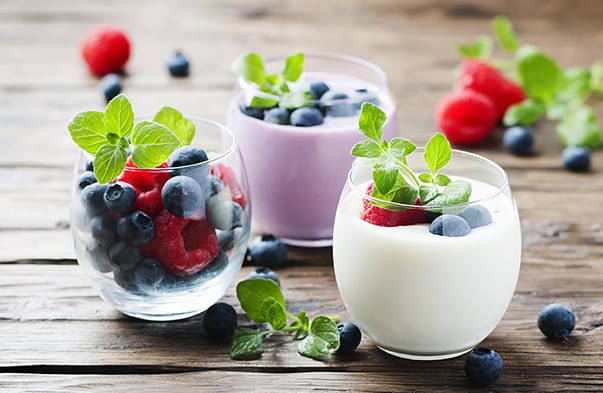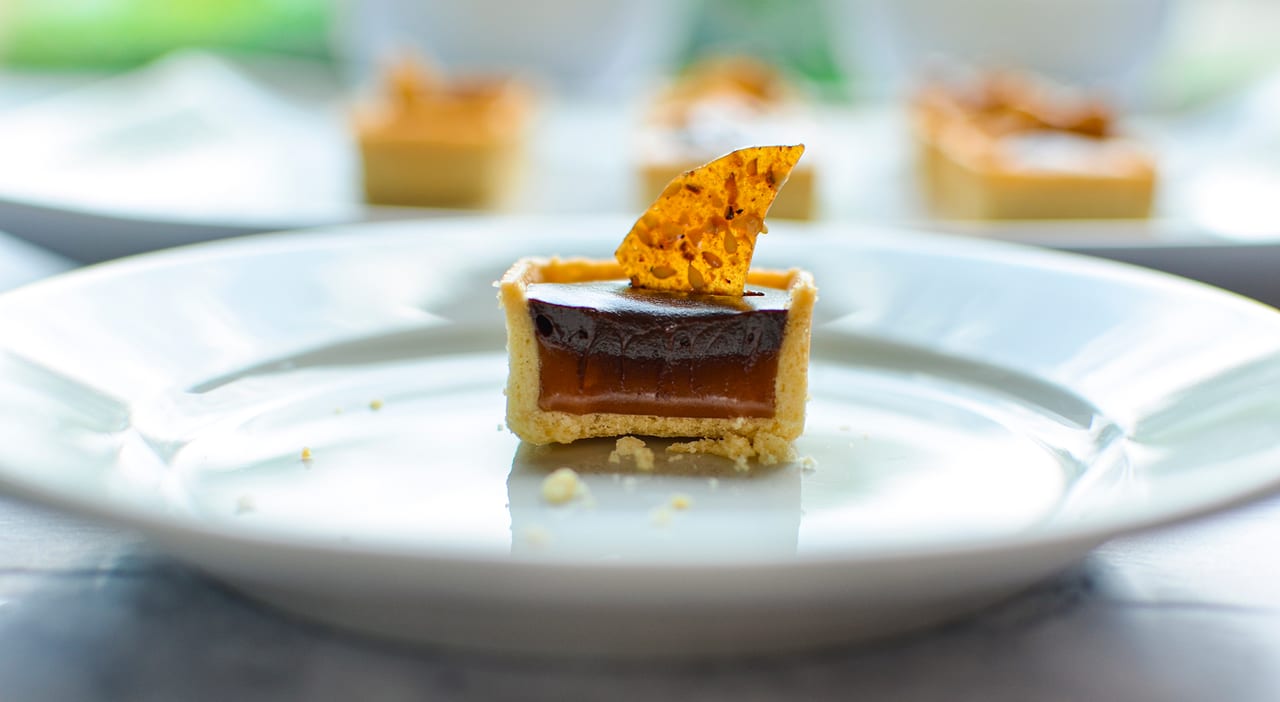Spot
SWEET
Hitting the
SUGAR REDUCTION

A look at the art and science of sugar reduction
By ALEXA BOSSHARDT, MPS, RDN, Contributing Ingredient Technology Editor
Photo courtesy of: Getty Images / smirart
In 2015, the World Health Organization (WHO) predicted a shift in consumer interest away from artificial high-intensity sweeteners and toward more natural alternatives. The organization cited safety concerns as well as potential toxicity concerns because of the negative impact some artificial sweeteners could have under environmental degradation. More than that, however, consumer demand was continuing to rise—not
only for “better for you” products, but also for better tasting, cleaner label foods and beverages.
For a sweetener, the perception of sweetness relies on how it works in formulation, how it is metabolized in the mouth, and how it binds with receptors on the tongue. Different sweeteners bind with different binding sites and the challenge of making a food or beverage “perfectly sweet” can be as much of a moving target as is the definition of “clean label.” Here are some tips and insights into using the currently popular sugar-reduction ingredients that can help processors hit the sweet spot.
New Sweet Kids
The near-zero-calorie sugar allulose, (sometimes referred to as d-allulose, psicose, or d-psicose) continues to be in the spotlight for its surprisingly clean flavor and versatility, as well as its nonglycemic qualities and ease of application. It also is favored as a reducing sugar, contributing to Maillard browning and caramelization in bakery applications. This naturally occurring “rare” sugar has undergone a price drop as technology for extracting it from corn, beets, and other plants has improved.
Allulose has an upfront sweetness onset similar to sucrose. While it can stand alone as a one-to-one substitute for sucrose, fructose, or glucose, it currently is still confined to an original GRAS limit of 30g/day. It provides excellent synergies when combined with high-intensity sweeteners and is suitable for a variety of beverage categories, including juices and soft drinks, even under high-heat processing conditions.

Allulose is a natural near-zero-calorie sugar that can replace nutritive sweeteners such as sucrose, glucose, and fructose without needing flavor maskers or bulkers. Photo courtesy of: Tate & Lyle, PLC
Stevia Still Growing Strong
Stevia sweeteners, especially the recent rebaudioside-M and rebaudioside-D forms noted for their cleaner taste, remain sugar-reduction leaders. They work especially well in low-pH products, such as beverages. They have demonstrated stability during pasteurization and other high-temperature processes as well. Stevia-based flavor enhancers with FEMA-GRAS approval for application in a variety of foods and beverages at a range between 40-100ppm are considered flavor modifiers, with no distinct flavor of their own, and serve to enhance sweetness perception in targeted sugar-reduction applications. They can lower added sugars and enhance sugar taste by up to 3° brix (Bx). Flavor systems can be built to include natural flavors, fruit extracts, and stevia or other “natural” high-intensity sweetener options to reduce sugar with clean labeling.
With greater hygroscopicity than sucrose, allulose can be used in base mixes for frozen dairy and non-dairy frozen desserts, such as scoopable ice-creams, gelato, and coated frozen confections and bars, at a maximum of 5% by weight. This maximum is recommended for guidance based on a presumed ingestion rate of allulose from an average serving of frozen desserts.
Sugars are hygroscopic, and so are attracted to—and bind well with—water. As such, they contribute desirable attributes such as maintaining softness in cookies and other baked goods. For foods optimized with brown sugars of any type, the caramel notes and moisture from molasses are impossible to replace with any low- or non-nutritive, high-intensity option. Light and dark brown sugars, with molasses ranging from about 3-6%, contribute distinctive caramel notes and color, as well as moisture.

Newer forms of stevia and stevia blends continue to approach the flavor and function of sucrose for many formulations. Photo courtesy of: SweeGen, Inc.
Sugar Sub for Dairy Sub
Sugar reduction in dairy and dairy-alternative products can be tricky when subjective attributes like flavor and mouthfeel are affected, as well as functional properties such as gelling and suspension. Although it is regarded as being 70% as sweet as sugar, allulose syrup or crystalline allulose can often be formulated successfully on a 1:1 replacement basis without a perceived difference in sweetness in most dairy alternatives. Allulose-sweetened frozen confections form desirable small ice crystals, as well as the same viscosity and creaminess as traditional ice creams, making allulose a viable replacement for corn syrup or high-fructose corn syrup.
Some low-viscosity glucose syrups, with 25% less sugar than a reference 42 or 63 dextrose equivalents (DE) corn syrup, can reduce total sugars while retaining existing standardized formulations. Viscosity is a consideration where more viscous options can cause production issues. Low-sweetness corn syrup products can still be labeled “corn syrup” and are manufactured using only partial hydrolysis of corn starch to dextrose, with no conversion of dextrose to fructose. Often, these ingredients are used more for their water-binding capacity than for sweetness.
Protein-based thaumatin, considered 100,000 times sweeter than sucrose, is caloric but contributes negligible calories because a tiny amount packs a big sweet punch. It is stable at boiling temperature at a pH below 5.5 for up to an hour, as well as during thermal processing such as pasteurization and canning in pH environments below 7.0. Thaumatin is hailed as both a low-calorie sweetener and a flavor modifier for many product categories, including chewing gum, dairy, pet foods, and animal feed. It masks bitterness and other objectionable notes when blended with high-intensity sweeteners, despite its own licorice-like linger.

Clean-label sugar reduction continues to be one of the leading consumer demands. Photo courtesy of: Ingredion, Inc.
The Left Hand of Sugar
Partially or fully inverted sugars retain softness in baked goods longer than does sucrose, and they help keep icings, confections, and fondants to keep them smooth, shiny, and free from cracking and drying. Although both have humectant and antimicrobial properties, partially inverted syrups generally are preferred for shelf-life extension. Commercial fondants, glazes, and icings are still primarily fully caloric, although 30% sugar-reduction fondants made with clean-label fiber fillers are available as fondant pastes, powders, and icing to be used for fillings, as well as doughnut and pastry glazes.
The recent trend in biomanufacturing of ingredients, receiving a lot of attention lately for the production of meat, seafood, and dairy proteins recently added sweeteners into the mix. A Swedish technology company has successfully used non-cell-based enzyme technology to produce the rare sugar kojibiose, occurring in trace amounts in the caramelization of sugar and found naturally in honey. It is a mildly sweet sugar with the unusual characteristic of being a prebiotic disaccharide, and thus helping to support digestive health.
Kojibiose was previously hard to synthesize, not to mention expensive. But the new enzyme technology makes possible high-volume, comparatively low-cost production of the novel ingredient possible. As such technologies are expanded and applied to other sweetener sources, more clean-label sugar-reduction options should continue to become available. PF
Alexa Bosshardt, MPS, RDN, is a research chef and industry consultant specializing in product formulation and nutritional marketing services for food and beverage manufacturers. With a culinary degree from Johnson & Wales and multiple degrees from Cornell University, Bosshardt is a regular contributor whose multiple articles on the sweet things in life can be found at www.preparedfoods.com. You can reach her at alexa@fitculinary.com.
January 2022
